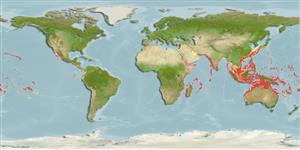Common names from other countries
>
Acanthuriformes (Surgeonfishes) >
Chaetodontidae (Butterflyfishes)
Etymology: Forcipiger: Latin, forceps = instrument of the pincers kind used for seizing and holding objects, esp. In surgical and obstetric operations + latin, gero = to carry; 1634 (Ref. 45335).
More on authors: Jordan & McGregor.
Environment: milieu / climate zone / depth range / distribution range
Ökologie
seewasser riff-verbunden; standorttreu; tiefenbereich 0 - 145 m (Ref. 89467). Tropical; 36°N - 32°S, 30°E - 79°W
Indo-Pacific: Red Sea and East Africa (Ref. 12484) to the Hawaiian and Easter islands, north to southern Japan, south to Lord Howe Island; throughout Micronesia. Eastern Pacific: southern Baja California, Mexico and from the Revillagigedo and Galapagos Islands (Ref. 5227, 11482).
Size / Gewicht / Alter
Maturity: Lm ? range ? - ? cm
Max length : 22.0 cm TL Männchen/unbestimmt; (Ref. 9710); max. veröff. Alter: 18 Jahre (Ref. 72479)
Rückenflossenstacheln (insgesamt): 12 - 13; Rückenflossenweichstrahlen (insgesamt): 19-25; Afterflossenstacheln 3; Afterflossenweichstrahlen: 17 - 19.
Common in exposed seaward reefs but also found in lagoon reefs (Ref. 9286). Benthopelagic (Ref. 58302). Solitary or in small groups of up to 5 individuals (Ref. 9286). Adults usually in pairs (Ref. 48636). Feed on a wide variety of animal prey including hydroids, fish eggs, small crustaceans but prefers tube feet of echinoderms, pedicilaria of sea urchins, and polychaete tentacles (Ref. 1602). Oviparous (Ref. 205), monogamous (Ref. 52884). Form pairs during breeding (Ref. 205). Second most important export in Hawaii (Ref. 37816). Minimum depth reported taken from Ref. 128797.
Life cycle and mating behavior
Geschlechtsreife | Fortpflanzung | Ablaichen | Eier | Fecundity | Larven
Distinct pairing (Ref. 205). Monogamous mating is observed as both obligate and social (Ref. 52884).
Myers, R.F., 1991. Micronesian reef fishes. Second Ed. Coral Graphics, Barrigada, Guam. 298 p. (Ref. 1602)
IUCN Rote Liste Status (Ref. 130435)
CITES (Ref. 128078)
Not Evaluated
Bedrohung für Menschen
Harmless
Nutzung durch Menschen
Fischereien: nicht kommerziell; Aquarium: Kommerziell
Mehr Information
ReferenzenAquakulturAquakultur ProfilZuchtlinienGenetikElectrophoresesVererbbarkeitKrankheitenVerarbeitungMass conversion
Tools
Zusatzinformationen
Download XML
Internet Quellen
Estimates based on models
Preferred temperature (Ref.
115969): 24.3 - 28.8, mean 27.5 (based on 710 cells).
Phylogenetic diversity index (Ref.
82804): PD
50 = 0.6250 [Uniqueness, from 0.5 = low to 2.0 = high].
Bayesian length-weight: a=0.02239 (0.01117 - 0.04486), b=3.02 (2.85 - 3.19), in cm Total Length, based on LWR estimates for this (Sub)family-body shape (Ref.
93245).
Trophic level (Ref.
69278): 3.1 ±0.2 se; based on diet studies.
Widerstandsfähigkeit (Ref.
120179): hoch, Verdopplung der Population dauert weniger als 15 Monate. (Preliminary K or Fecundity.).
Fishing Vulnerability (Ref.
59153): Low vulnerability (12 of 100).
